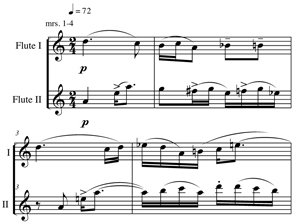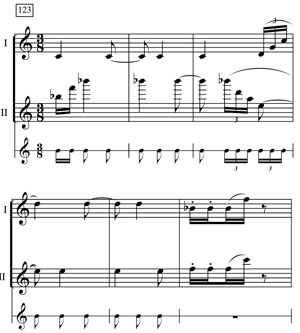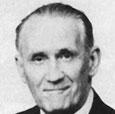Many gems of relatively unknown flute pieces are included in The NFA 20th-Anniversary Anthology of American Flute Music, the goal of which is to demonstrate the “quality, technical mastery, and seriousness of American musical composition in the twentieth century.” Of the three flute duets therein, Roger Goeb’s Two Divertimenti stands out as a lively and unique contribution to the flute duet repertoire. I discovered the work while looking for a duet to include on a two-flutes-and-piano recital.
Roger Goeb (1914-1997)
Roger Goeb was born in Cherokee, Iowa in 1914. He studied piano as a child and also learned to play trumpet, French horn, viola, violin, and other woodwind instruments. After high school he earned a Bachelor of Science degree in agriculture at the University of Wisconsin in 1936. He spent the next two years playing in jazz bands before enrolling in the École Normale de Musique in Paris, where he studied with Nadia Boulanger.
Upon returning to the United States in 1939 he began working privately with Otto Luening, who himself composed an extensive number of flute works. He took some graduate-level courses at New York University and eventually earned a Master of Music degree from the Cleveland Institute in 1942. His doctorate was done at Iowa State University in Ames. He subsequently taught at Bard College, The Juilliard School, Stanford, Columbia, and the Bennington Composers Conference in Vermont.
Goeb composed prolifically for orchestra and chamber combinations, and from the late 1940s through the early 1960s his works were performed frequently. Along with five symphonies, he wrote violin and piano concertos, the American Dances for string orchestra, a quintet for trombone and strings, and four string quartets. He also produced four woodwind quintets, piano and cello quintets, and six more orchestra pieces in the 1980s: Divertimento, Memorial, Caprice, Fantasia, Essay, and Gambol.
He is important not only for his musical contributions, but also for the work he did with the American Composers Alliance (ACA), a group that supports the performance, broadcast, and recording of contemporary American works. He served as their executive secretary for many years. In 1952 he also established the Composers Facsimile Edition, later known as the American Composers Edition, that aimed to make copies of its members’ works available between the times their works were completed and published.
In 1964 he gave up composing for more than a decade to tend to his wife and son, both of whom had multiple schlerosis. After their deaths he returned to composition until suffering a stroke in 1986. Goeb died on January 3, 1997.
Two Divertimenti
The Two Divertimenti was written in 1950 and embodies his compositional style with clear structure, economical use of musical materials, novel timbres, interesting rhythms, and inherent lyricism. The title refers to the divertimento form – a traditionally light musical work meant to please the ear and provide recreation rather than express complicated shades of emotion. Though this definition implies a simple work, Two Divertimenti is anything but. In the liner notes of the 1988 recording, A Tribute to Otto Luening, which includes the duet, Goeb described the work:
“The Two Divertimenti concentrate on musical values a bit more than the title and the choice of instruments might suggest. The lightness and fluency one expects from two flutes is evident, but at the same time there is a complex interplay between the instruments. Occasionally there are combinations that sound like a single instrument doing remarkable things, and sometimes there seem to be more [than] two instruments performing. These orchestrational notions and certain melodic and harmonic ideas challenge the expertise of the performers and make virtuosic demands on them.”

Movement I
In 2/4 with a tempo indication of quarter note = 72, the movement has a natural, walking feel. The most notable aspect of it, and of the work as a whole, is the buoyant off-beat rhythms that propel the light and open musical lines forward again and again. The openness results from the near constant use of perfect fourths and fifths. The movement’s tonality also relates to these perfect intervals. Instead of traditional harmonies and chord progressions, there are tonal centers of two important pitches at a time. The movement begins with pitch centers D and A and then moves through D flat and A flat, E and A, D and G, B and F, and E and A.
The major challenge here is performing extremely clear and precise articulations so that the rhythmic interplay is clearly audible. The voices rarely line up, and when they do, it is often to highlight musical climaxes. Each flutist must count as if his or her life depended on it, for the life of this piece certainly does.
Blending is another performance challenge. Measure 26 highlights the importance of blend with its sudden change in texture. A rhythmic figure is traded back and forth. When both flutists match tone colors, note lengths, intonation, and vibrato, it can be a mesmerizing experience for the audience.
.jpg)
This musical effect lasts for two measures and the composite rhythm, or the rhythm that the audience perceives, is:
![]()
After brilliant sextuplets of parallel fourths, the trading-off figure is repeated at a much louder dynamic level, and it is also condensed by omitting the eighth note, which makes the composite rhythm sound faster. This kind of passage returns later in the movement in measure 108 as well.
A second notable section of the first movement begins in measure 50, where a series of trilled motives begin. Strive to give the impression that there is a constant blanket of trills through which little interjections poke. These trills begin at a perfect fourth, with A flat in the second flute and E flat in the first.

Later in measure 67, the trill cushion expands to a perfect fifth, with A in second flute and E in first. The intensity, speed, and tone colors of the trills should match. It is important to note that every trill should move at the whole step. There is a probable misprint in measure 67, where the second flute switches to the new trill: the second flute trill should be from A to B – not A to Bb as indicated in the score.
The interjection notes are all marked with either a tenuto line or a staccato to show that Goeb clearly wants them to stick out of the trill texture. The non-trill notes of both flutists connect to make a melody, an effect that can create the illusion of three flutes playing instead of two. The example below shows both flute parts and the imagined melody of the third flute, implied by the interjections.
.jpg)
Movement II
The second movement is in 38 at dotted quarter = 72, not quarter =72 as indicated in the score. The quarter-note pulse of the first movement becomes the pulse for an entire measure in the second movement, an element that adds continuity. The second movement feels faster because the new beat is divided into three eighths instead of two.
The pentatonic tonalities that Goeb uses provide a pleasant and folksy feel throughout this movement, which begins in A major pentatonic and continues to fluctuate between this and Bb major pentatonic, traveling through the pitch centers of E , G, and C.
Many of the challenges mentioned in the first movement are found in the second as well. For example, the rhythmic gesture in the first measure returns often, and with each return it must be executed exactly the same way.
Grace notes are found throughout the movement and both flutists must match the way they play them. In general it will help to play relatively quick and chirpy grace notes so that they do not interrupt the pulse. This example illustrates a passage thick with grace notes.

Like the first movement, this one has some interesting composite rhythms, such as this one from measure 123. Here the parts begin to alternate repeated quarter notes causing the listener to hear an articulation on each eighth note pulse. The score and the composite rhythm that the audience should perceive are shown below.

General Practice Tips
Two Divertimenti overflows with examples of interesting textures. Studying the score to know when these moments occur and exactly what makes them special is an important step in learning the duet
Preparing your own part is not enough to perform this piece well; you should learn the other part as well. By going through the extra effort to learn both parts, the complicated rhythmic exchanges will make more sense to you and the audience. One of the best ways to practice Divertimenti is to switch parts in rehearsals.
Another way to practice the duet is for both flutists to play the first part simultaneously, with an ear to blending and matching. Then do the same with the second part. Lastly, trade parts: the first flute playing the second part and the second flute playing the first part. When you finally return to your original part, it will seem much easier.
To practice blending, isolate a musical passage and play a game of call and response. For example, the first flute could play the opening measure of the second movement, after which the second flute could immediately repeat that same passage trying to mimic exactly. These roles can easily be switched, for example using measure 25 of the second movement, where the second flute states a motive which the first flute then imitates.
In order to breathe life into this duet and make Goeb’s use of familiar tonalities sound fresh and novel, pay careful attention to intonation, articulations, and dynamics. Intonation is essential for the perfect fourths and fifths which permeate the work. Passages of parallel 16th notes, like those found in measure 6 of the first movement and measure 55 of the second movement, should be practiced very slowly to be sure that each interval maintains its open and perfect quality.
Slow practice will also provide the opportunity to focus on accurate articulations. Goeb marked his constantly changing articulation patterns carefully and purposefully, making them an integral part of the composition. It is helpful to mark moments in the score where both flutes articulate together or where they are homorhythmic. Adhering to dynamic markings will help achieve the “lightness and fluency” to which Goeb refers. His dynamic markings are relatively sparse; most are either piano or forte, with occasional moments of pianissimo and fortissimo.
Flute players are lucky to have a wealth of duets, and Two Divertimenti is a special contribution to this rich repertoire and well worth considering if you are searching for a new flute duet to perform or even just to noodle through with a friend.





